76 Years Later: Argylls Remember Our Fallen
Introduction – 1 November 2021
Last year, the cancellation of Remembrance Day ceremonies spurred the Argyll Regimental Foundation (ARF) to an online commemoration. It was well received. This year will add another 28 biographies, one daily, which will be mounted on the ARF’s website.
“First casualties – … Coy despondent – realize that it’s war”
The oral history project, begun in 1984, that culminated in Black yesterdays: the Argylls’ war (1996) was an attempt, spurred by the Argyll veterans themselves, to relate their history in their own words. As I explained in last year’s introduction (below), Capt Claude Bissell, CC, provided me with a guiding light to that tale of men at war by reading – before I interviewed him in 1984 – the last symphonic paragraphs of Maj Bob Paterson’s brief history of the 10th Canadian Infantry Brigade, in which the Argylls served.
Over the course of that first summer of interviews and the autumnal revelation that I would be writing a “different sort of book” (the words of Brigadier General Doug Fearman), Maj Paterson’s words took hold. I had an inchoate yet intuitive sense that these words grasped the heart of that experience. We later estimated that about 75 percent of the Argylls interviewed broke down recalling battle. It could be attributed to the sound, the fury, and the fear intertwined in that confrontation. But it was more than that: it was the encounter with the face of death, the monstrous face of battle. CSM George Mitchell of C Company (“George the Great,” “George the One-Man Army”) wrote in his private diary on 26 July 1944: “France!! – Great anticipation.” Three days later, that tone disappeared: “First casualties – P. Hindle [Pte Percy Samuel Hindle] – McCann. Coy despondent – realize that it’s war. Enemy shelling hot and heavy.”
During the Second World War, approximately 3,300 men served in the Argylls: 289 Argylls were killed in action; 808 were wounded; 72 were prisoners of war; and over 200 were injured or left because of illness, for a total of 1,638 (or 41 percent) of those who served. The 1st Battalion went into battle in late July 1944 with just over 800 soldiers; all save a handful of the aforementioned casualties occurred between 25 July 1944 and 6 May 1945.
“It had come, it was here, it was over … and we were silent in our wonder”
Small wonder, then, that Maj Paterson’s words had such resonance and power. It is worth repeating them here. He concluded his book, written in 1945, just after the cessation of hostilities. At its conclusion he ruminated about the army message bringing the great conflict to a halt:
All offensive Ops cancelled forthwith. Cease fire 0800 hrs 5 May 45
Thus, in these simple, terse, military words and abbreviations, was found the crystallization of over five years of millions of hopes and millions of prayers. It had come, it was here, it was over … and we were silent in our wonder. How many had listened for those words before, and had always said to themselves – “to-morrow.”
And now that to-morrow had come – a to-morrow called peace. But to us it didn’t seem like the end of anything as yet. The skies were overcast, the rain dripped slowly from the thatched roof of the farmhouse, the lake looked grey and cold and a cutting wind shook steel-like raindrops from the new green leaves. All was very quiet. The men at Brigade had been gambling by the stove when they heard the broadcast. They rushed outside and called wildly to one another. Five minutes later they were back by the fire and their cards. The quiet returned. No it was not apathy – it was something there is no word for, a feeling too large to express, to know, yes, even to exist. One kept saying to oneself – “it’s over,” “it’s over,” all the time half expecting to see a rainbow in the sky, to hear the shouts of millions in Trafalgar or Times Square, to experience some outward manifestation of joy, praise, thankfulness, or of great emotion flooding through the gates of restraint. But nothing happened. There were no bells in Germany, there were no happy people, and the conquerors were dumb in the greatness of their relief.
Perhaps in the months to come will that fabulous “to-morrow” really be to-day – a day when all the bells and voices of our great memories shall ring out, cry out, peal, and shout, in one wild tumultuous song of thanksgiving. Sometime, while dreaming over a sun drenched lake, while pausing in the fields to watch the summer clouds pile one upon the other, or in the quiet half hour before sleep, we shall hear that symphony we once listened for, and it shall swell and reverberate through our beings in unforgettable strength and beauty so that we shall know that to-day has come, and that those black yesterdays are forever left behind.
— Major R. A. Paterson, A & S H of C, Holland, 1945
“those black yesterdays are forever left behind”
Some weeks ago I met with Pte Michael Augustine O’Neil’s three children: Dr Mary Kay O’Neil, Michael O’Neil, and Nancy Eichenberg (O’Neil) to discuss their father and his forthcoming Argyll Poppy. I told them about the Black yesterdays project and its origins. I read Maj Paterson’s words. Dr O’Neil replied: “They are beautiful.” Indeed.
The biographies of Argylls killed in action have often benefitted from letters, images, and memories provided by family. Last year, I asked Col Alan Earp, OC, who commanded the Pioneer Platoon from November 1944 until he was wounded on 14 April 1945, if he knew Capt Jack Prugh. I included Alan’s response in Capt Prugh’s biography:
Alas, I never met Jack Prugh, although I had heard well of him. Thanks to the material you have put together I know him better now. Virgil summed it up in six almost untranslatable words; ‘sunt lacrimae rerum et mentem mortalia tangunt’. (The best I can do is a prosaic ‘Tears well up as the human condition touches the heart’.)
“Tears well up as the human condition touches the heart”
Virgil’s words, with Alan’s translation, capture the impact of these Argyll deaths upon their families. Often, the ideas of service and sacrifice are reduced to names and statistics, thereby minimizing, although not deliberately so, the meaning of those words in terms of the lives lived. Professor David R. Winter, Brandon University, is the grandson of LCpl Frederick Woodward Jr, whose biography appeared last year [there is a picture of a rather young Professor Winter with his grandfather’s biography]. David wrote me: “It is so very poignant when the scale of the war is reduced to the level of a single soldier.” The observation is apt and contains echoes of Maj Hugh Maclean’s foreword to Black yesterdays.” “Why men fight,” or, for that matter, why they enlist in the first place,” Hugh wrote, “are matters scarcely considered in the Green Book [the 1953 history of which he authored 8 of 11 chapters – the war chapters], which has not very much to say about the impact of battle on individual combatants.” More broadly, Maj Maclean noted favourably the invitation to readers:
… to consider individual motivation and performance by officers and equally by enlisted men on every level. Why did these farmers, high-school boys, college students, salesmen, truckers, and the rest enlist in the Argylls? How did each come to terms with the challenges of military life, in the midst of a world at war?
“the Canadian soldier’s range of response to the bitter test of battle”
But, there was more:
In any case, larger questions remain, bearing on the discordant impact of war’s alarms on these men-at-arms, together with the Canadian soldier’s range of response to the bitter test of battle; in particular, the developing sense (or, now and again, the sinister atrophy) of what is required – call it courage – from those who find themselves called on to command in battle.
“all doctors, in the discipline of war – of life, at last, and death too”
Over 40 years after the war’s end, the gifted Maclean wrote in gripping and illuminating fashion of the characteristics of the wartime battalion, his regiment. There was “the regiment’s style … a manner, if you like, with which to confront the inscrutable face of battle, and endure in spite of it.” He touched on Capt Malcolm “Mac” Stewart Smith (KIA 8 April 1945 with Lt Alan Earp at his side). Mac Smith referred to everyone as doctor – “his common ‘doctoral’ denominator. For Mac Smith, we were all doctors, in the discipline of war – of life, at last, and death too.”
of “death too”
This month of November 2021 brings us together again in remembrance of their experience of life, of battle, and of “death too.”
Albainn Gu Brath,
Robert L. Fraser
Regimental Historian
[Note: I wish to thank Col Glenn Gibson and LCol Glenn De Caire of the Argyll Regimental Foundation for their encouragement and support. Julia Armstrong, ARF’s Website Quartermaster, provides significant aid, and this task would be impossible without her. My longtime Argyll friends from the 1980s and 1990s – Col Rick Kennedy, LCol Tom Compton, Capt Steve Richardson, Capt Larry Henderson, and Lt John Ferguson – have endured for decades now. And there are many, many others from the succeeding decades. “Young” Lt Earp’s counsel, insight, and memory are simply indispensable and his friendship esteemed. What I have learned over the years is owed, in large part, to my Argyll mentors: Capt Claude Bissell, CC; Maj Hugh N. Maclean; Maj Bob “Flan” Paterson, Capt Sam Chapman, BGen Doug Fearman, LCol Pete Stephen, Cpl Harry Ruch, and Pte Mac MacKenzie. Pte Jake Leyland never failed to remind me “to remember the boys left over there.” Cpl Gord Boulton deemed it fitting and important to include the families of the “boys left over there.” For Jake and Gord, we’re trying. RLF].
Foreword
“death in battle is different from the inevitable end which every man ultimately reaches”
Capt Sam Chapman, D Coy, 1943–45
In a final salute to four of his wartime Argyll comrades (three of whom were killed), Capt Claude Bissell wrote: “In battle, death became a statistic noted with sad resignation. The dead then joined a shadowy company that grew in numbers each day.” That “shadowy company” of the dead grew to 288 by war’s end. It was commanded by the Argylls’ padre without a peer, the beloved Capt Charlie Maclean.
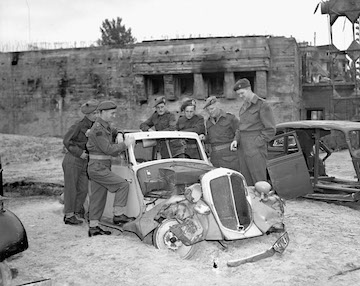 Capt Charlie Maclean (on left) with a group of Argylls, Berlin, 9 July 1945.
Capt Charlie Maclean (on left) with a group of Argylls, Berlin, 9 July 1945.
When we started what became the Black yesterdays project in 1984, I conducted my first interview. Our student interviewers, all senior undergraduates, were awed by the prospect of interviewing Canada’s most distinguished university president of the 20th century – Claude Bissell. The task fell to me. I had started the first year of my doctorate at the University of Toronto in Bissell’s last year as president. When I called him at home, the initial response was gruff, but that tone disappeared at the mention of one word – “Argyll.”
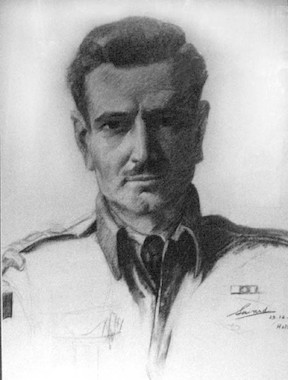 Lt Claude Bissell (charcoal portrait by Pte Fred Savard; this copy hangs in the Savard Room of the Argyll Officers’ Mess.)
Lt Claude Bissell (charcoal portrait by Pte Fred Savard; this copy hangs in the Savard Room of the Argyll Officers’ Mess.)
We got together at his comfortable home in the summer of 1984. I met him and his “Scottish charmer” of a wife, Christine, and their daughter, Deirdre. After coffee and a convivial chat, we set to the work at hand. Upon reflection, it is clear to me now that Bissell had prepared a lodestar for me at the start of my journey with the 1st Battalion. He told me pointedly that he considered the final paragraphs of Maj Bob Paterson’s history of the 10th Canadian Infantry Brigade compelling. Their cogency derived from the fact that they captured, with a symphonic quality, what the end of the war meant to the soldiers in the field – exhausted relief. Whilst crowds thronged the streets of the world in joyous celebration, the victors were mute.
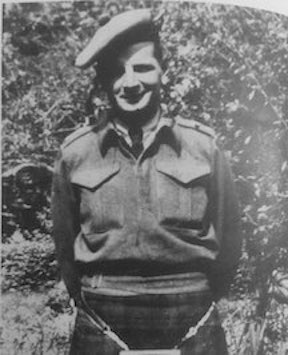
Claude Bissell
I emerged from the interview with three things: first, an admiration of Capt Bissell; secondly, a title for the book that lay on the horizon – Black yesterdays; thirdly, direction to interview another Argyll university president, Lt Alan Earp, president of Brock University.
The interviews of 1984 had, as Bissell would later write about infantry regiments, a common set of memories as well as individual ones. The interviews bore out his observation. There were two immediately apparent collective memories: the first, pride in the Regiment; the second, the black yesterdays of battle that stemmed from the knowledge that, as Capt Sam Chapman put it, “we belong to an organization with a history bought by blood.”
As the structure of Black yesterdays took shape, Pte Jake Leyland persistently asked, “What about the boys left behind?” Initially, I had considered a Roll of Honour but decided to include their names, along with the number of wounded, after the war diary entry. I also put together a chapter called “The Wounded and the Dead.”
What follows is a selection from that chapter: Argylls meditate on the terrible price of battle. Every day this month, I shall post a brief entry on a life lost, along with an image. We shall remember.
Robert L. Fraser
Regimental Historian
Introduction
November tends to be a sombre enough month in most of Canada, with the commemoration of two World Wars, and now made more so by the menace of the 2020 pandemic and its disruption of our “normal” lives. It, in turn, serves as a salutary reminder of the almost forgotten “Spanish flu” of 1918-19, which took more lives than the Great War itself. Quite understandably in these circumstances, almost everywhere commemorations of the 75th anniversary of the end of the Second World War in Europe, and celebration of the 75 years of (relative) peace that war made possible, have had to be abandoned.
To the few surviving veterans of the 1st Battalion, that has been “Our War” (the other was their parents’). They know only too well that this did not end in August of 1944 with the Liberation of Paris. (“Tell that to The Argylls!”, and to any of the Canadian Divisions that slogged on through France and Belgium, breached the Siegfried Line, and accepted the surrender of the German Army in the West. Tell it to the Americans who fought the Battle of the Bulge in December 1944. And, above all, tell that to the Dutch!).
In the Netherlands, major commemorative events planned for the first week of May were among those overtaken by Covid-19, but, as any who have visited that country know, the Dutch never forget and ”Those We Left Behind” continue to be honoured by successive generations.
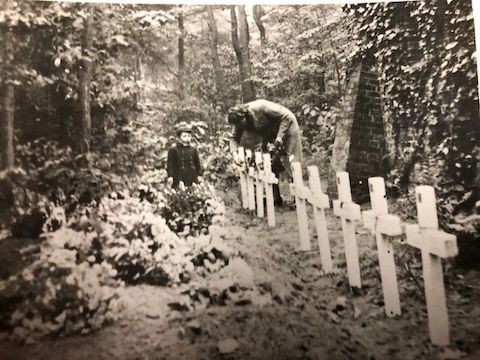
Dutch civilians tending Canadian graves, 1945.
In Waalwijk, on the Maas, I have been corresponding with a spirited high school class who have made The Argylls the focus of their study. They put together a lively, upbeat commemorative magazine, “Vrede & Vrijheid,” and had hoped to cover the Argyll regimental route from Normandy to the Netherlands in August of this year by bicycle. They were able to attend a ceremony on a now very peaceful Kapelsche Veer, at which Polish, British, and Canadians were represented, on that once benighted little island where so many Allied lives were lost. They have also visited many of the nearby sites that were familiar to The Argylls … from Bergen op Zoom to Loon op Zand.
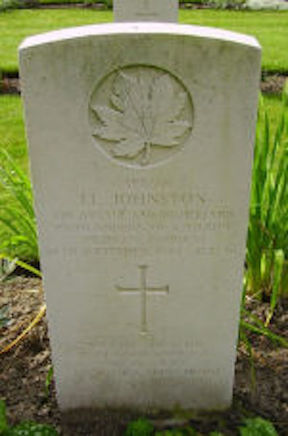
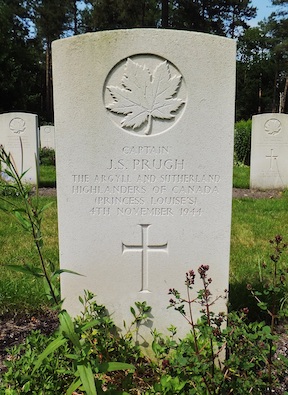
Gravestones of Capt Lloyd Johnston and Capt John S. Prugh.
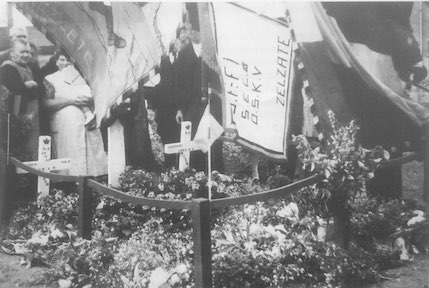
Graves of LSgt Grey and Pte Cole.
And in Holten, one of several Canadian War Cemeteries in which Argylls are buried. Jan Braakman, a Dutch volunteer who himself lost relatives in German concentration camps, has produced a documentary film which focuses on six of the 1,387 Canadians buried there, and the impact of their deaths on their surviving families and close friends in Canada, where much of the footage was taken. One of the six is an Argyll, Pte Cecil French, whose poignant letter to his mother of March 24, 1945, is printed in Black yesterdays. “Cec”, his friend, Pte John Brown, and Lt-Colonel Fred Wigle, were killed in the same action on April 14, 1945, in Holten, lie in adjacent graves [Lt Earp was wounded in that action]. (In the row behind is the grave of Captain Malcolm “Mac” Smith, “Smitty“ to so many of the 1st. Bn. He had been killed at Meppen a week earlier [Lt Earp was standing beside him when he was killed]). These are just two examples of the continuing connection; Holland is a mine of many more.
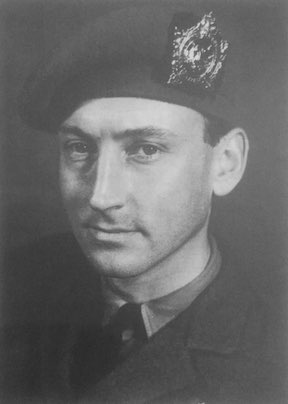
Lt-Colonel Fred Wigle

Mac Smith
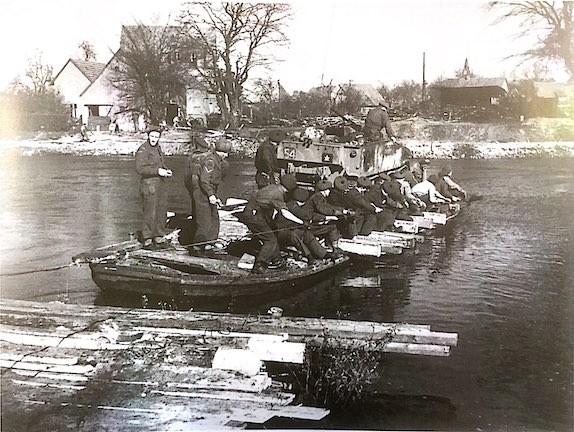 Lt Alan Earp, Pioneer Platoon, standing near the centre of the barge, wearing a pistol, with his right hand on his hip. Earlier, Capt Mac Smith was killed, standing beside Earp, from a single shot fired by Germans concealed in the wood piles on the far side of the canal. 8 April 1945.
Lt Alan Earp, Pioneer Platoon, standing near the centre of the barge, wearing a pistol, with his right hand on his hip. Earlier, Capt Mac Smith was killed, standing beside Earp, from a single shot fired by Germans concealed in the wood piles on the far side of the canal. 8 April 1945.
Meanwhile, within the Argyll family, thanks in no small measure to Dr Robert Fraser, Lt.-Col Tom Compton, and other volunteers and family members, we have commemorative projects of our own, some of them made possible by the skilful use of new technologies. Our ever-growing virtual Poppy field has caught the eyes and interest of many, as have the profiles and sepia photographs from both World Wars and the Regimental Association’s on-line newsletter. Sometimes, www.ancestry.ca, or a TV advertisement for it, leads to another link or longer periods at home allow for further exploration and, in turn, new contacts and discoveries – perhaps a cache of letters or other memorabilia. All this activity, of course, bodes well for our future but takes time to process. I know that for Dr. Fraser, updating the already huge Black yesterdays file is still an ongoing project. What I do not know is where he and Lt.-Col. Compton find the time to do all this. The Regiment is greatly indebted to them both and to all those who assist.
Today’s Argylls are rightly focussed on being ready for whatever Canada or our community may require of them. (Who would have thought a year ago this would include a crisis caused by a pandemic?) Fortunately, in the last 75 years this has not involved casualties on the scale that was once the lot of every infantry battalion. But, and especially in the wider Regimental family, we do not forget “Those We Left Behind,“nor those who preceded us and helped to bring about the peace we have enjoyed. These daily profiles this November are part of that recognition.
Albainn Gu Brath,
Lt Alan Earp, Pioneer Platoon, 1st Battalion A & S H of C, 1944-45,
later Alan Earp, OC, Honorary Colonel, 2002-11
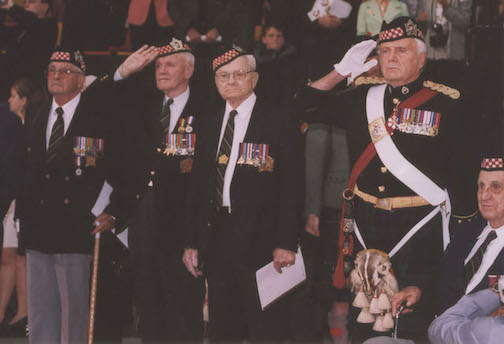
Col Alan Earp, OC, (on the right, saluting) at Trooping of the Colours, October 2002
From Black yesterdays: the Argylls’ war (1996)
Reminiscence. Capt Doug Bryce. MO
[Dr Bryce replaced Dr W. Bie as the unit MO in November 1944.]
…I think that in general that I was of the Regiment, but still a member of the Medical Corps rather than the infantry. The question is … was the regimental medical officer … responsible to the Medical Corps or to the Colonel of the Argylls? There was no particular dichotomy here. All tactical activities were the responsibility of the Colonel. It would be hard to imagine, except in matters which might influence the health of the troops, that the medical officer would appeal to the Medical Corps – the ADMS – over the head of the Colonel … Never a case of that.
…The RMO and RAP had two or three vehicles. He had a sergeant in charge, a corporal and stretcher bearers … his job in action was to follow the line of attack … to give first treatment to the wounded and to sort out those that should be transferred back as fast as possible and those that could be put off for a few hours. His management of wounds was essentially massive first aid [and] the use of blood and plasma where indicated. When not in action, the RMO was involved more in the general hygiene of the camp, the … [daily] sick parade and the usual daily problems of any group of people … Supplies came up with the regimental medical supplies … I do not recall ever being short of anything, except perhaps in some areas when we were isolated, as in the Hochwald forest action, when there was difficulty in getting supplies up to the RAP because of shelling or bad road conditions in the rear…
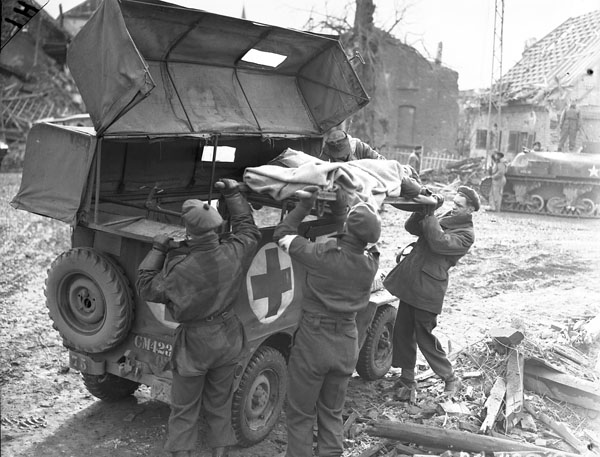
RCAMC jeep, 6 March 1945, Sonsbeck. The two soldiers on the right belong to the medical corps, the soldier on the left wearing a balmoral is possibly an Argyll. The Argyll Tac HQ was in Sonsbeck until it moved easterly at 1500 hrs. If he is an Argyll, it is also possible that the wounded soldier is an Argyll. Two Pioneers were wounded on Schu mines early in the day: A/Sgt John Dickson and Pte Harry Turner. The Dickson family thinks, given the glimpse of a thick head of hair on the wounded soldier, it may be A/Sgt Dickson.
The stretcher bearers were, generally speaking, some of the bravest of men … some of them were battle fatigued people who just couldn’t go back to the line, but were used in areas further back from action. There was no way to prepare stretcher bearers for the type of wounds and type of problems they would come across. The majority of the stretcher bearers in an armoured division rode on jeeps and so did their stretchers – and they were exposed to as much fire as anybody else, the difference being that they did not fire back…
In general, when the action was going on the people that came back were either dead or almost dead, in which case there was no particular problem. The wounds that I recall being the most severe were the compound fractures, where we had to use the Thomas’ splints, and the head injuries, which were perhaps the most difficult to get used to … In most cases the medication that was of the greatest use for seriously ill patients was intravenous morphine, of which we had a good supply … we were usually supplied with a large amount of rum to give to wounded patients and, in fact, that would be the worst thing you could possibly give to a severely wounded patient or to one who was battle fatigued or was terrified to the point of hysteria. Usually to give them any alcoholic beverages would have a very bad effect indeed, and require them to have to be tied down…
I think dirt, inability to clean and lack of rest were the problems that – aside from the actual wounds – gave us the greatest trouble. Certainly, the so-called battle fatigue was also a great one where many young men who were unable to stand the tension of day-after-day combat would just collapse and become inert and refuse to obey orders or carry out any action whatsoever. This was perhaps the greatest problem with the medical officer, who was constantly being asked by the other officers whether this soldier or that soldier was indeed a genuine battle casualty or was merely trying to get out of the front line. That was a question that was almost impossible … There was no particular answer to that problem, except the general principle that it’s better to keep the men up in the lines rather than to send them back as once they got back out of the lines, it was almost impossible to get them up again.
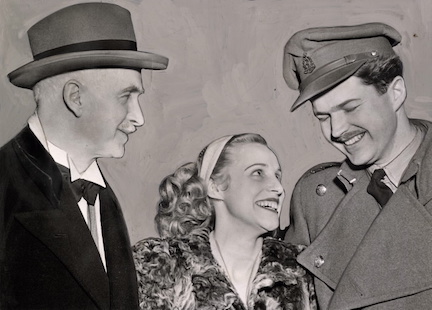
Capt Douglas Bryce, MO, welcomed home by his father and wife.
…I treated wounded civilians and we assisted them medically in any way we could. We often, when occupying areas that were at least semi-friendly on the way to Germany, had quite a bit to do with civilians who provided the troops with food and provisions when they had them, and generally were supportive. As a MO, we treated Allied troops, many German wounded and civilian wounded on an equal basis … one of the few sensible things about the war was that the soldiers of either side were happy to have medical care by anybody who would provide it.
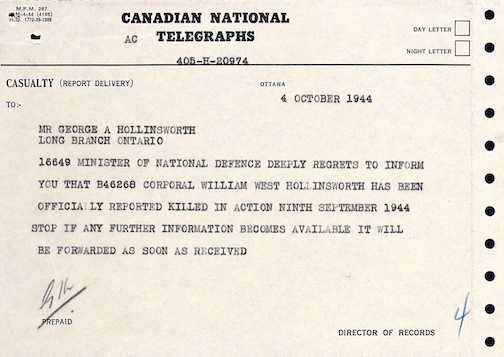
Telegram announcing death of Cpl W.W. Hollinsworth, 4 Oct. 1944.
The Dead
Interview. Pte Mac MacKenzie. D Coy
…We died hungry and tired – or hungry and exhausted in fear. That’s the way we died, or all my friends died…
Interview. Pte Sidney Webb. Signals Platoon
I prayed a lot, but that’s the only recourse you have. I’m not religious … but you prayed a lot. I used to pray that I wouldn’t get wounded, and then after a while I realized that it was going to have to happen sooner or later, and I started to pray when I do get wounded, I hope it won’t be very serious … I never prayed that I wouldn’t be killed. Never even thought of it. It was always somebody else, not yourself … I never thought I was going to be killed. You always think you’re going to be different.
Capt Sam Chapman to his wife. 20 October 1944. C Coy
…You know it’s funny the way people seem to feel things coming – twice since I’ve been here fellows who were normally healthy happy-go-lucky guys who had seen plenty expressed a feeling that their luck was running out and within a matter of 2 days bought one. I suppose it’s sheer coincidence + that hundreds of people of people say such things + nothing happens + no more is thought of it – but boy it sure shakes you just the same…
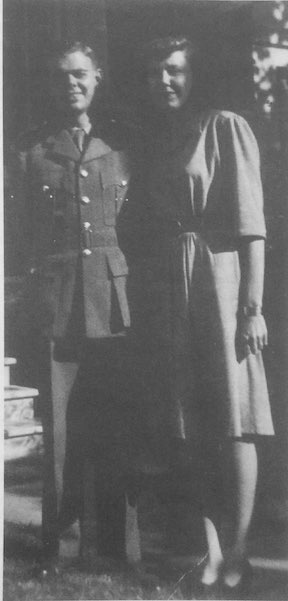
Capt Sam Chapman with his wife, Mardy.
Interview. CSM Tommy Dewell. D Coy
…the other guy, maybe he’s going to get killed. I had guys killed right beside me. Didn’t bother me. I guess I was too hard-hearted in this to worry about getting killed. You’re in action and if you’re going to get killed, you’re going to get killed. If you’re not going to get killed, why worry about it? That’s the way my idea was, anyway.
Interview. CSM Wilf Stone. A Coy
…fellows that were with the Regiment from the beginning, when they got hit, that was more traumatic than, say, somebody who got hit who’d only been with the Company or the Battalion for three or four months. It was the guy who you’d known for years that hurt the most … You did get over it, because you’re just as concerned about yourself. And I believe everybody felt, “Well, that happens to him, but it’ll never happen to me…”
…I had dysentery at one point, I had crabs several times, and I was lousy a good part of the time. Now, when you get a situation like that, then it’s gonna drag you down … As time progressed, you knew it also could happen to you, and this [was] the type of thing that would drag you down … You knew that you couldn’t last forever, and you just hoped that it was going to be a nice, easy one if you did get hit…
Interview. A/Sgt Jim Potticary. Carrier Platoon
…My basic philosophy was if “I’m going to get killed, I’m going to get killed,” and that’s the way I looked at it. And being a Catholic and brought up … by Jesuits and that, I said, “If I’m gonna die, I want to die clean.” That’s the whole thing. So that’s the way I thought about things…
Interview. Pte Bob Post. D Coy
…There were some times there when we were up, say, in a dry ditch, waiting to advance some place or take a village. And you see the stretcher – the jeeps were equipped with four stretchers –and you’d see the fellows coming back. And the kind of shape they were in, you’d wonder how the hell are you going back? – or if you’re going back at all … This is what crossed my mind lots of times: “How the hell are you going back?”
Interview. A/Cpl Melvin Junck. D Coy
…it hurts you. If it’s someone you’ve known for a lot of years and suddenly you see them lying there. It really hurts, it really upset you at the time … [But] you didn’t get too much chance to think or worry about these things. They came and they went, and you just had to keep on going. You didn’t take time to really worry about it.
Interview. Pte Anonymous. D Coy and Mortar Platoon
…one didn’t react as one thought one should react … and I think that on occasion bothered me … I often felt I should have reacted perhaps a little differently than I did … I didn’t shrug it off. But then there were certain people, for some reason or other, that you’d hear that they were killed, [and it] would probably upset you more…
Interview. Capt Bob Pogue. Pioneer Officer, Scout Officer and B Coy
You just don’t reflect on it [death]. You find that inside, you just get more tired and tired and tired. And what is contributing to all this is this – all these deaths. And I think part of the feeling is … there’s a particular instinct for survival, and you’re still there. It’s as if you were shooting dice … and well, you came up alright on that one. There is a peculiar feeling, there’s no question about it. Certain deaths affect you more than others, but there comes a time [when you realize] there isn’t anything you can do about it.
Interview. Cpl Kurt Loeb. I Section
…we had people on that island [Kapelsche Veer] that were killed. And then they lay for about twenty-four hours while the Germans were still firing rockets onto it. And their bodies were just dissipated. When the barrage ended a few days later, our people went out and brought them in –in blankets, as was the custom – to bury them … the blankets are usually human shape … tied together like you see on a stretcher. These blankets [at Kapelsche Veer] were about twenty-four [inches] by twenty-four. They were just bits of body parts…
I slept in this town in a big hall … I remember … it was an anteroom where I slept. And there was a doorway – a glass doorway – to the sort of a general … chamber. In that room next to mine, not where I was sleeping but maybe twelve feet away, they had placed these blankets and these bodies. You had seen death; you had seen people dead. At least I didn’t know who these people were. But these horrible blankets, the obscenity of it. They were so small, you know, all chopped up…
Interview. Pte Gerry Beaudoin. A Coy
…I remember when the first few of our people were killed in August [1944], one extremely good friend of mine was killed and it broke me up. And every time I’d hear of somebody else later on, it hurt … Never got calloused. I could turn around and say look at the casualty list there, there’s two hundred and some killed in action. It’s only a statistic. But I think it’s this guy that I used to go out with, we went out and got drunk together in Niagara and Jamaica and the west coast and then England. That other guy’s up in the next bunk to me in Jamaica there … these people are dead. This hurts.
Interview. Cpl Harry Ruch. 7 Platoon, A Coy
…casualties were more personal the first part of the action because they were men … that you had been associated with day in and day out. Now you’re associated with them more than you are your brother, and they were the first casualties. Well, later on the men … came from the west coast and the east coast. They weren’t as personal as the first group of casualties.
Interview. Major George Mills. OC, Hdq Coy
[One of the tasks of OC, Hdq Coy was sorting through the kit of those killed prior to it being returned to the next-of-kin.]
…Anything that you felt … might hurt somebody [was removed]. It wasn’t a very pleasant job. It kept me up many nights. Very distasteful, actually, because you felt that you had to be very careful and that you did not dispose of something that would be of value to … those left. And you didn’t want something to go through your hands that might cause some grief.
Lt Norm Donaldson to his wife. 29 January 1944. A Coy
…Incidentally Darling, do you know what one of the Padres jobs is? When a man dies or is killed, he must go thru his kit in order to remove any letters or pictures etc., before his kit is forwarded to his wife. That’s true!…
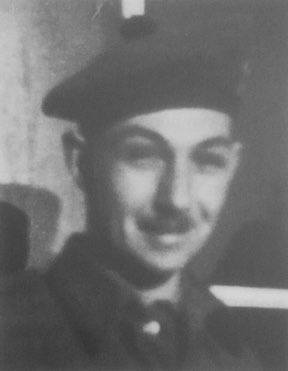
Lt Norm Donaldson
Interview. Lt Harold Place. B Coy
I wrote a letter to one family and personally got accused by his mother of stealing his personal effects. And it was really nothing to do with me. That was untrue. It’s up to BHQ to send the personal effects on, and I gather that she didn’t receive any and she took it out on me, due to the fact that I had written … There was something in particular that she wanted, and it may have got separated from his personal effects. Maybe he left a kit bag somewhere and it never did get back to BHQ. Pretty hard to make people understand that, so I just quit writing.
Capt Sam Chapman to his wife. 7 November 1944. C Coy
…I finally finished the last of the letters to fellows [sic] next of kin this evening. I was just on the point of boggin down on the job this afternoon when the mail came and there was a letter in it from a woman I’d written to when I first came. It was pathos in the extreme – but such sincere appreciation that I felt a little ashamed that I’d been putting so little real effort into writing them good letters…
Capt Chapman to his wife. 28 April 1945. HQ, 4th Cdn Armd Div
…I also got a letter from the mother of one of the kids who was killed by our own artillery in the Veen affair. (I didn’t tell her that.) When I came in I reported everybody who wasn’t there as missing, though I knew of several dead gave the detailed dope 6 hrs later + quite a few turned up alive. And she says that there was over a week between the telegram that said he was missing and the one that said he was killed. And because of the first they’d gone on hoping even after the 2nd till they got my letter, so I guess I slipped pretty badly there…
Interview. Lt Lloyd Grose. A Coy
…I know the first [conscript] chap that was killed, I had to write a letter to the family. And boy, did I ever get a hostile letter back because he had been killed. He was killed on the first day he got to the unit. A sniper got him in the Hochwald, just at the base of the Hochwald.
Interview. Cpl John Day. Signals Platoon
…I always took the impression, “I hope I get hit right between the eyes,” because I was always afraid of losing a leg or something. I’d just as soon have been dead and got it over with. But this is a kid’s attitude…
Interview. Cpl Pinky Craig. Anti-Tank Platoon
…To this day I don’t know who come along and buried them [the Argyll dead]. Somebody must have come along and buried them because we didn’t bury our own … [But] we didn’t have much to mourn. You thought about it a lot; but just like today, life had to go on and you just went on with other things, and that was it.
Interview. Pte Sidney Webb. Signals Platoon
…I made a practice that I never looked at them [dead Argylls]. I could look at the Germans … didn’t bother me. But to see your own fellows, I just, I divorced it from my mind. I would look at them but I wouldn’t see them … I didn’t stare at them, I’d just keep on walking. Well you see them, you just see them laying there and sometimes you couldn’t see their faces, sometimes you could … I wouldn’t stop. I wouldn’t even look at them, I’d just see the wounds … [and] keep on going.
Interview. Pte Bob Johnston. D Coy
…Sometimes [in action] you just get a quick look or a quick thought [for lost comrades] and that was it. You had to move on. But you thought about it when you came out for a rest. Like sometimes you’d come out for a two-week rest … and you’d think about it … But when you’re up there, you don’t get a chance to think about it. You’re too busy. You’re on the move, preparing for the next day…
Reminiscence. Capt Bob Pogue. Pioneer Officer, Scout Officer and B Coy
…In my early forties I suffered a period of melancholia brought about by nagging remembrance of the deaths of men I had admired and respected – my best friend, Bill Wilbur, killed in Italy with the 48th [Highlanders]; my own comrades – Jock Rennie, Arv Dalpé, Norm Donaldson, Lloyd Johnson, Mac Smith – and so on. The thought would constantly come back in my mind – why these men? Why not me? Emotionally I will always feel that these soldiers, from private to colonel, were among the best that Canada can produce.

Capt Lloyd Johnson
Reminiscence. Capt Sam Chapman. C and D Coys
The inner response of each of us is intensely personal – and however different from the response of others it is equally valid. For some this … is a ritualistic acknowledgement that we belong to an organization with a history bought by blood and peopled by giants and we experience a feeling of pride and exultation at being a part of it; for some it invokes a vivid image of an evening spent sharing with some good friend a game of cards, a bawdy limerick, a drink, some very private concerns – and of wrapping that friend’s body in a blanket before the next evening had come; for some it is a moment to recall a father, a friend or a relative who also died in battle and whose sacrifice brings us closer to those Argylls whose memory we honour even though they were not known personally and belonged to an earlier generation; for some it triggers a flight of fancy back to younger days when our bodies were more lithe, our minds more keen and our spirits more lively and life, however tenuous, was experienced at a level of intensity never since matched – and which, secretly, we think of as the greatest years of our lives.
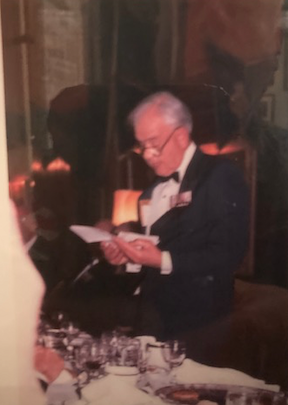
Capt Sam L.G. Chapman giving the Toast to Fallen Comrades, Fall Mess Dinner 1987.
All of these are authentic reactions. All flow from an unarticulated acknowledgement that death in battle is different from the inevitable end which every man ultimately reaches. Normally, a man dies in the bosom of his family, at peace with his God, and after receiving the best possible medical care. He is mourned by his friends who take solace in the knowledge that he had his innings; he had his chance to make his mark in business or the academic world, to inspire others by his knowledge and example, to see his children grow and take their place in society. Death is the natural end to a cycle of life. In contrast, the man who falls in battle is far from his family; circumstances dictate that his medical care is less than ideal; his comrades may be there but are so involved with the task in hand that they can give him scant attention. He is cut down in an instant with all his future a page now to remain forever blank. There is an end but no conclusion.
Some of those we recall … died early still gripped by that paralytic fear which engulfs even the bravest man the first time he comes under enemy fire and realizes that those shells and bullets are meant to kill him. Others died late in the war after defying the odds so often that they had almost become convinced of their own invulnerability. Others, wounded once or even more often, fell after returning against all common sense and over the pleas of their loved ones. It was as if they were possessed by an inner force bent on their destruction.
Heroes all! But they were not thinking to be heroes. Not infrequently, before an impending action they asked one of another, “Why do normally intelligent prudent men expose themselves to such risk?” The standard answer was to produce some tattered family snapshots of children or younger siblings and to say “For them.”
That reply is worthy of some examination. For they well knew that in whatever the post-war world would be, fatherless children would not share on an equal basis. The truth is they had a much broader and less selfish vision than the well being of their own families. What they really meant, but were too self-conscious to put into words, is that they were willing to die, even willing to jeopardize the future of their families – in some cases to forego the possibility of having families – because they had a different vision of a future for all mankind.
Their dream was misty and ill defined, as dreams are wont to be, but it embodied a world in which all people were free, a world released from cruelty and inhumanity, where sharing was the norm. In the society which they sought to create the pursuit of power would be an outrage and a misuse of power the ultimate crime. They died with the conviction that no immediate personal sacrifice was too great a price to pay for the future common weal.
If we set their vision against what we see … we find wide disparities. Human affairs are not governed by giving and sharing but by blatant self interest … With such thoughts, we cannot help but be haunted by the notion that perhaps, like Don Quixote, those who fell died fighting for a world so unrealistic and so impossible that they were in reality victims of their own ideals.
I suggest, in all humility, that the fault lies not in their dream but in us. And I ask that, as we honour them … we remember not only the sacrifice they made but the vision they had and recommit ourselves to achieve it each in our own way. If, because of their example, we can strive to move a little closer to the world they cherished, then they will not have died in vain. Every name on the Regimental Honour Roll, from Col Wigle to the most junior private, is a constant inspiration to every one of us.
They were Argylls, all! – and heroes.
“a history bought by blood”
Capt Sam Chapman, D Coy